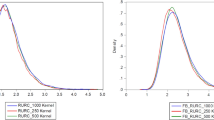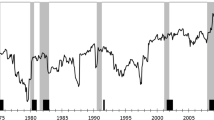Abstract
This article presents tests of the random walk hypothesis for the U.S. and world commercial real estate markets along with the world stock market through utilizing appropriate market indices. The augmented Dickey-Fuller and Phillips-Perron unit root tests and Cochrane variance ratio test find each of these markets to exhibit random walk behavior. In addition, Johansen-Juselius cointegration tests reveal that the three markets are not cointegrated. The vector autoregressive model shows little or no predictive power in explaining the variation in monthly returns. The generalized impulse response functions suggest that shocks stemming from one market are quickly disseminated to the other markets within two months. (JEL G14, G15)
Similar content being viewed by others
References
Asabere, P., R. Kleiman, and C. McGowan. 1991. “The Risk-Return Attributes of International Real Estate Equities.”Journal of Real Estate Research. 6(2): 143–152.
Campbell, J., and G. Mankiw. 1987. “Permanent and Transitory Components in Macroeconomic Fluctuations.”American Economic Review 77: 111–117.
Case, B., W.N. Goetzmann, and K.G. Rouwenhorst. 1999. “Global Real Estate Markets: Cycles and Fundamentals.” ICF Working Paper, Yale School of Management.
Cochrane, J. 1988. “How Big is the Random Walk in GDP?”Journal of Political Economy 96: 893–920.
Corgel, J.B., W. McIntosh, and S.H. Ott. 1995. “Real Estate Investment Trusts: A Review of the Financial Economics Literature.”Journal of Real Estate Literature 3(1): 13–43.
Dickey D., and W.A. Fuller. 1979. “Distribution of the Estimate for Autoregressive Time Series with a Unit Root.”Journal of the American Statistical Association 74: 427–431.
Dwyer, G.P., and M.S. Wallace. 1992. “Cointegration and Market Efficiency.”Journal of International Money and Income 11: 318–327.
Eichholtz, P.M.A., R. Huisman, K. Koedijk, and L. Schuin. 1998. “Continental Factors in International Real Estate Returns.”Real Estate Economics 26: 493–509.
Granger, C.W.J. 1986. “Developments in the Study of Cointegrated Economic Variables,”Oxford Bulletin of Economics and Statistics 48: 213–228.
Johansen, S., and K. Juselius 1990. “Maximum Likelihood Estimation and Inference on Cointegration with Applications to the Demand for Money”Oxford Bulletin of Economics and Statistics 52: 160–210.
Kleiman, R.T., J.E. Payne, and A.P. Sahu. 2002., “Random Walks and Market Efficiency: Evidence from International Real Estate Markets.”Journal of Real Estate Research 24 (3): 279–297.
Koop, G., M.H. Pesaran, and S.M. Potter. 1996. “Impulse Response Analysis in Nonlinear Multivariate Models.”Journal of Econometrics 74: 119–147.
Ling, D.C., and A. Naranjo. 1999. “The Integration of Commercial Real Estate Markets and Stock Markets.”Real Estate Economics 27(3): 483–515.
Liu, C.H., and J. Mei. 1998. “The Predictability of International Real Estate Markets, Exchange Rate Risks and Diversification Consequences.”Real Estate Economics 26(1): 3–39.
Lo, A., and A. MacKinlay. 1988. “Stock Market Prices Do Not Follow a Random Walk: Evidence from a Simple Specification Test.”Review of Financial Studies 1(1): 41–66.
MacKinnon, J.G. 1991. “Critical Values for Cointegration Tests in Long-Run Econometric Relationships.” InReadings in Cointegration, edited by R.F. Engle and C.W.J. Granger (pp. 226–276). New York: Oxford Press.
Mills, T.C. 1999.The Econometric Modelling of Financial Time Series (2nd edition). Cambridge, U.K.: Cambridge University Press.
Myer, F.C.N., M.K. Chaudhry, and J.R. Webb. 1997. “Stationarity and Cointegration in Systems with Three National Real Estate Indices.”Journal of Real Estate Research 13(3): 369–381.
Newell, G., and J. Webb. 1996. “Assessing Risk for International Real Estate Investments.”Journal of Real Estate Research 11(2): 103–115.
Osterwald-Lenum, M. 1992. “A Note with Quantiles of the Asymptotic Distribution of the Maximum Likelihood Cointegration Rank Test Statistics.”Oxford Bulletin of Economics and Statistics 54: 461–472.
Payne, J.E., and H. Mohammadi. 2004. “The Transmission of Shocks across REIT Markets.”Applied Financial Economics. Forthcoming.
Pesaran, M.H., and Y. Shin. 1998. “Generalized Impulse Response Analysis in Linear Multivariate Models.”Economics Letters 58: 17–29.
Pesaran, M.H., and R.P. Smith. 1999. “Structural Analysis of Cointegrating VARs.” InPractical Issues in Cointegration Analysis, edited by M. McAleer and L. Oxley (pp. 55–89). Oxford, U.K.: Blackwell Publishers.
Phillips, P.C.B., and P. Perron. 1988. “Testing for a Unit Root in Time Series Regression.”Biometrika 65: 335–346.
Richards, A.J. 1995. “Comovements in National Stock Market Returns: Evidence of Predictability, but Not Cointegration.”Journal of Monetary Economics 36: 631–654.
Seck, D. 1996. “The Substitutability of Real Estate Assets.”Real Estate Economics 24(1): 75–95.
Sephton, P.S., and H.K. Larsen. 1991. “Tests of Exchange Market Efficiency: Fragile Evidence from Cointegration Tests.”Journal of International Money and Finance 10: 561–570.
Wilson, P.J., and J. Okunev. 1999. “Long-Term Dependencies and Long Run Non-Periodic Co-Cycles: Real Estate and Stock Markets.”Journal of Real Estate Research 18(2): 257–278.
Ziering, B., Y. Liang, and W. McIntosh. 1999. “REIT Correlations with Capital Market Indexes: Separating Signal from Noise.”Real Estate Finance 15(4): 61–67.
Ziobrowski, A., and R. Curcio. 1991. “Diversification Benefits of U.S. Real Estate to Foreign Investors.”Journal of Real Estate Research 6(2): 119–142.
Author information
Authors and Affiliations
Corresponding author
Rights and permissions
About this article
Cite this article
Payne, J.E., Sahu, A.P. Random walks, cointegration, and the transmission of shocks across global real estate and equity markets. J Econ Finan 28, 198–210 (2004). https://doi.org/10.1007/BF02761611
Issue Date:
DOI: https://doi.org/10.1007/BF02761611




